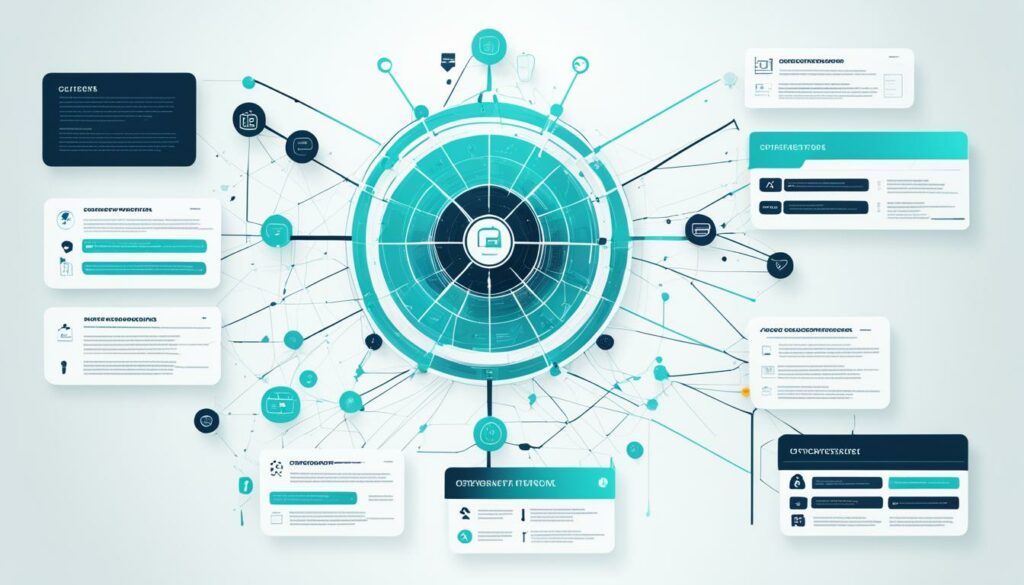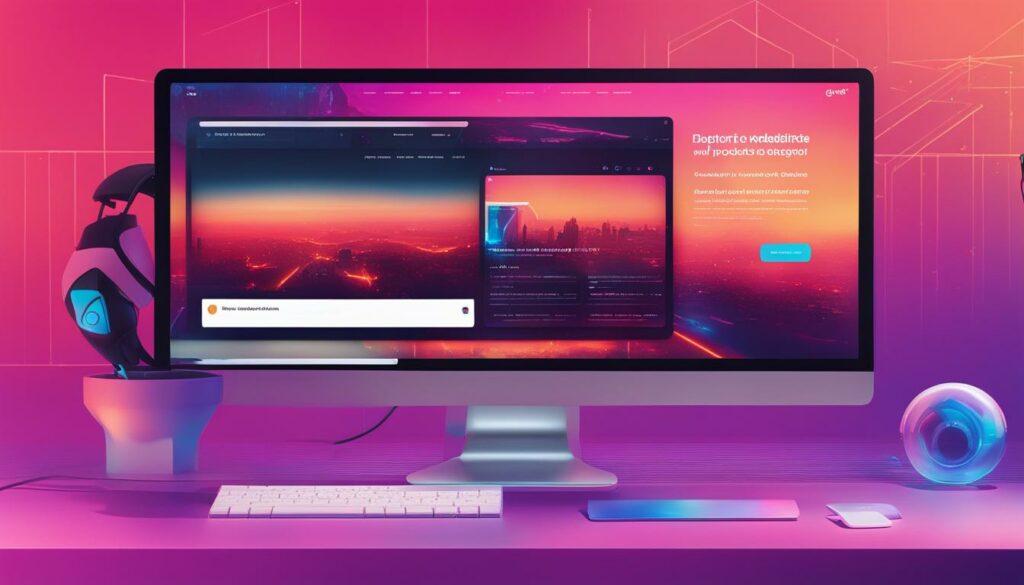A successful enterprise website is the nexus of your company, connecting customers and your business. As your business grows, the structures supporting your website need to develop accordingly. Enterprise websites should be scalable, have compliant security measures, clear information architecture, conversion-focused design, a unified design system, responsive design, reliable customer support, and the right hosting plan to fit your needs.
Key Takeaways:
- Scalability is vital for the success of an enterprise website. It should have the capability to handle increased capacity and high traffic.
- Compliant security measures are crucial to protect your business and gain customer confidence.
- Clear information architecture ensures a seamless user experience, making navigation effortless.
- A conversion-focused design attracts and converts browsing users into loyal customers.
- A unified design system ensures consistency and efficiency in your enterprise website design.
Scalability – Vital for Business Growth
Scalability is a vital factor for the success of an enterprise website. As your business aims for growth and success, your website needs to scale up in volume accordingly. To accommodate increased capacity and handle high traffic, robust hosting is essential. But scalability goes beyond that.
Scaling your website also entails collecting and managing user data at scale. This requires a reliable customer relationship management (CRM) system, which allows you to effectively nurture and maintain relationships with your growing customer base. Additionally, having an organized content management system (CMS) ensures that your website can handle the ever-increasing amount of content without compromising performance. With a scalable website, you can accommodate organic growth and seamlessly incorporate new needs as your business expands.
To illustrate the importance of scalability, let’s consider an example. Imagine you operate an e-commerce store that experiences a sudden surge in sales. Without scalable web hosting services, your website may crash under the increased traffic, resulting in frustrated customers and missed revenue opportunities. However, by leveraging a scalable hosting solution, your website can seamlessly handle the influx of customers, ensuring a smooth shopping experience and maximizing sales.
In summary, scalability is not just about accommodating growth; it’s about providing a solid foundation for your website to handle increased capacity, high traffic, and evolving needs. With the right scalable web hosting services, along with reliable CRM and CMS systems, you can support your business’s growth and ensure a seamless user experience.
Case Study: The Impact of Scalable Web Hosting Services
| Company | Before Scalable Web Hosting | After Implementing Scalable Web Hosting |
|---|---|---|
| AceTech | Website frequently crashed during peak traffic hours. | Website handled high traffic seamlessly, resulting in increased conversions and revenue. |
| GloboShop | Website experienced slow load times and occasional downtime during flash sales. | Website maintained optimal performance, ensuring a smooth shopping experience even during high-demand events. |
| GreenLeaf Media | Website struggled to handle the increased content volume, leading to cluttered user experience. | Website effectively managed the growing content library, providing users with a clean and organized interface. |
Compliant Security – Protecting Your Business and Customers
In today’s digital landscape, securing your enterprise website is not only vital for protecting your business but also for gaining customer confidence. Implementing proper security measures helps safeguard sensitive information and mitigates the risk of a security breach. By prioritizing secure web hosting, you can ensure the safety of your website and the data it holds.
To evaluate the security practices of your web hosting service provider, look for SOC 2 compliance. SOC 2 compliance assesses the effectiveness of security controls, ensuring your service provider follows industry-standard security best practices.
Enhancing user login security is crucial to protect your enterprise website and your customers’ accounts. Implementing single sign-on (SSO) and two-factor authentication (2FA) adds an extra layer of protection, making it more difficult for unauthorized individuals to gain access. SSO allows users to use a single set of login credentials across multiple systems, reducing the risk of weak passwords. 2FA requires users to provide an additional verification code, typically sent to their mobile devices, further strengthening the login process.
Security threats such as phishing emails, spyware, and malware continue to evolve, making it essential to educate your team on security best practices. By training your employees to identify and avoid potential security risks, you can minimize the chance of a security breach. Regularly updating software and implementing robust security solutions and protocols further enhance your website’s security posture.
“Implementing strong security measures is not just a choice; it’s a necessity in today’s digital world. By prioritizing customer data protection and following security best practices, you can safeguard your business and build long-lasting customer confidence.”
Clear Information Architecture – Enhancing User Experience
Clear information architecture is crucial for an enterprise website to provide a seamless user experience. The layout and design should follow a logical logic, anticipating users’ expectations and mental models. A good information architecture connects users to the information and features they are looking for, making navigation effortless. Keeping user expectations in mind while designing navigation, buttons, and forms helps create an effective enterprise website.
When users visit your website, they have specific goals and expectations in mind. A well-designed information architecture ensures that they can easily find the information they need, engage with your brand, and complete desired actions. By organizing your website’s content and features in a logical and intuitive manner, you can enhance user experience and drive conversions.
The IA Institute is a renowned organization that focuses on information architecture and promotes best practices in the field. They emphasize the importance of understanding users’ mental models and designing navigation systems that align with their expectations.
Intuitive Navigation and Mental Models
Intuitive navigation is a key aspect of a clear information architecture. Users should be able to navigate through your website effortlessly, without having to think too much about where to find the desired information or features. By mapping out your website’s structure and applying common design patterns, you can ensure that users can easily locate what they’re looking for.
Mental models play a crucial role in designing effective navigation systems. Users have pre-existing mental models of how websites work based on their previous experiences. By aligning your navigation with these mental models, you can make it easier for users to understand and navigate your website.
“Good navigation is about following conventions and balancing between predictability and surprise.” – Jesse James Garrett, Co-founder, Adaptive Path
Designing an Effective Enterprise Website
To create an effective enterprise website with a clear information architecture, consider the following tips:
- Understand your target audience: Conduct user research to gain insights into their needs, preferences, and browsing habits. This will help you create an information architecture that caters to their expectations.
- Define clear goals and user journeys: Determine the primary goals of your website and define user journeys to guide users toward those goals. This will help you structure your content and navigation accordingly.
- Organize content hierarchically: Categorize your content into logical groups and arrange them in a hierarchical structure. This allows users to navigate through different levels of information effortlessly.
- Use descriptive labels and clear menu options: Label your navigation elements with concise and descriptive titles that accurately represent the content behind them. Avoid generic labels that could confuse or mislead users.
- Provide search functionality: Include a search bar on your website to allow users to quickly find specific information. Make sure the search functionality is robust and provides relevant results.
- Optimize for mobile devices: With the increasing use of smartphones, it’s essential to ensure that your website’s information architecture translates well to mobile screens. Implement responsive design techniques to provide a seamless user experience across devices.
By implementing these strategies, you can create a clear information architecture that enhances the user experience of your enterprise website, making it easier for users to find what they need and achieving your business goals.

Having a clear information architecture is essential for an effective enterprise website. It enables users to navigate seamlessly and find the information and features they are looking for. By prioritizing user experience and aligning navigation systems with mental models, you can create a website that engages and converts visitors. Information architecture is the foundation of a successful digital presence.
Conversion-Focused Design – Optimizing User Engagement
When it comes to your enterprise website, one of the most critical elements is conversion-focused design. This design approach aims to attract, educate, and ultimately convert browsing users into loyal customers. By implementing strategies that optimize user engagement, you can enhance the effectiveness of your marketing initiatives and increase conversion rates.
Real-time marketing plays a vital role in conversion-focused design. It allows your marketing team to make changes on the fly based on customer behavior insights. By analyzing real-time data, you can adjust your marketing strategies and content to meet the evolving needs and preferences of your target audience.
One effective way to gather actionable data and improve user experience is by including a site search field on your enterprise website. A well-designed site search field enables users to easily find the information or products they are looking for. Additionally, it provides you with valuable customer behavior insights, such as popular search terms or frequently searched items, which can inform your marketing and website optimization efforts.
“Including a site search field on your enterprise website can drive conversion rates by providing actionable data and improving user experience.”
Benefits of Conversion-Focused Design:
- Increased conversion rates: By optimizing the design elements and user experience, conversion-focused design can significantly improve the likelihood of users taking the desired actions, such as making a purchase or submitting a contact form.
- Improved marketing ROI: When your website is designed with conversion in mind, your marketing initiatives become more targeted and efficient, leading to a higher return on investment (ROI).
- Enhanced customer satisfaction: A user-friendly design that aligns with the needs and expectations of your target audience can greatly improve customer satisfaction and loyalty.
- Actionable data for decision-making: By collecting data on user behavior and preferences, you can make data-driven decisions to continuously optimize your website and marketing strategies.
Incorporating conversion-focused design into your enterprise website can have a significant impact on your overall business success. By combining real-time marketing, customer behavior insights, and actionable data from your site search field, you can create a website that not only looks visually appealing but also drives conversions and provides an exceptional user experience.

Real-Life Example: Increasing Conversion Rates through Design
To illustrate the power of conversion-focused design, let’s take a look at how Company XYZ managed to double its conversion rates by implementing a few key design changes:
| Design Change | Conversion Rate Before | Conversion Rate After |
|---|---|---|
| Streamlining the checkout process | 3% | 7% |
| Implementing clear call-to-action buttons | 2% | 5% |
| Adding product recommendations | 1% | 4% |
By focusing on optimizing their website design and user experience, Company XYZ was able to achieve a significant increase in conversion rates. These simple design changes made it easier for users to navigate, understand the value proposition, and take action, resulting in a substantial improvement in their overall business performance.
A Unified Design System – Ensuring Consistency and Efficiency
A unified design system is essential for maintaining consistency and improving efficiency in your enterprise website design. By implementing design guidelines and utilizing pre-built elements, you can create a unified and cohesive user experience throughout your site. This unified approach ensures that everyone in your company has a single source of truth to refer to, resulting in a more streamlined and efficient design process.
Design guidelines provide a framework for designers to follow, ensuring consistency in elements such as typography, color schemes, and layout. These guidelines serve as a reference point for maintaining brand identity and creating a cohesive visual language.
Design guidelines act as guardrails for designers, providing a clear direction and reducing the need for excessive decision-making. They enable teams to work collaboratively and ensure a unified design across various projects.
Pre-built elements, such as templates and design components, offer a library of reusable assets that can be easily integrated into your website. These elements not only expedite the design development process but also contribute to consistency and efficiency by eliminating the need to reinvent the wheel for each new project.
Design System in Webflow
Webflow is a powerful web design platform that provides a robust design system framework. With Webflow’s design system capabilities, you can create and manage your unified design system in a streamlined and intuitive manner.
- Build design libraries: Organize and categorize design assets, including typography, color palettes, and reusable components.
- Create style guides: Define and document design guidelines, ensuring consistency throughout your website.
- Utilize pre-built templates: Access a wide range of professionally designed templates that can serve as a starting point for your projects.
- Collaborate effectively: Enable your design and engineering teams to work seamlessly together, facilitating a streamlined design process.
By leveraging Webflow’s design system capabilities, you can speed up the design and prototyping process, resulting in a more efficient and cohesive website design.

A unified design system not only ensures consistency in visuals and interactions but also enhances the overall user experience. With a well-defined design system in place, your enterprise website will exhibit a cohesive and professional look, reinforcing your brand and instilling confidence in your users.
Responsive Design – Optimized for All Devices
In today’s digital landscape, it’s crucial to ensure that your enterprise website is accessible and functional across all devices. With 92.8% of internet users accessing the web via mobile devices and 62% of buyers making purchases on their smartphones, responsive design is no longer just a nice-to-have feature – it’s a necessity.
Responsive design is a design approach that adapts the layout, typography, and images of your website to different screen sizes and orientations. By optimizing your website for mobile devices, you create a beautiful and functional user experience that caters to the growing use of smartphones and mobile web browsing.
A responsive design makes your website legible and visually appealing on smartphones, tablets, and desktop computers alike. It ensures that users can easily navigate and interact with your website, regardless of the device they are using. With a responsive design, you won’t have to worry about users zooming in to read text or struggling with buttons that are too small to tap.
Did you know? 92.8% of internet users access the web via mobile devices, and 62% of buyers make purchases on their smartphones.
By implementing responsive design, you provide a seamless user experience across all devices. Whether a user is browsing on the go or sitting at their desktop computer, they can enjoy a consistent and optimized experience on your website.
“With responsive design, your website adapts to the device being used, ensuring a consistent and user-friendly experience for all visitors.”
The Benefits of Responsive Design
Responsive design offers several benefits that contribute to a positive user experience and drive business results:
- User Experience: By optimizing your website for different devices, you create a user-friendly experience that keeps visitors engaged and encourages them to explore further.
- Increased Reach: With a responsive design, your website reaches a wider audience, including mobile users who make up a significant portion of internet users.
- Improved SEO: Search engines value responsive design as it provides a consistent experience for users across all devices. This can positively impact your search engine rankings and organic visibility.
- Easier Maintenance: With a responsive design, you only need to manage one website, making updates and maintenance more efficient.
Implementing responsive design is essential in today’s mobile-driven world. It ensures that your enterprise website meets the expectations of your users and provides a seamless experience, regardless of the device they are using.
Conclusion – Optimize Your Enterprise-Level Web Hosting
Now that you have gained valuable insights and best practices for enterprise-level web hosting, it is time to optimize your website. Scalability, compliant security, clear information architecture, conversion-focused design, a unified design system, responsive design, reliable support, and the right hosting plan are critical for the success of your enterprise website.
First, ensure that your web hosting solution offers scalable services to accommodate your business’s growth. Reliable web hosting solutions with high-performance infrastructure are essential to handle increased capacity and high traffic.
Moreover, prioritize secure web hosting with compliance measures such as SOC 2, single sign-on, and two-factor authentication to protect your business and instill customer confidence.
To enhance user experience, focus on clear information architecture and conversion-focused design. Utilize a unified design system to maintain consistency and efficiency across your website, and implement responsive design for optimal performance on all devices.
Lastly, choose a web hosting provider that offers customizable plans and managed services, ensuring that you have the robust infrastructure and reliable customer support needed to meet your enterprise-level requirements.
In conclusion, by following these best practices and optimizing your enterprise-level web hosting, you can create a professional and scalable website that performs at its best, keeping your business secure and delivering an exceptional user experience for your customers.
FAQ
Q: What is enterprise-level web hosting?
A: Enterprise-level web hosting refers to web hosting services that are specifically designed to meet the needs of large businesses or organizations. These hosting solutions offer robust infrastructure, high-performance capabilities, and scalability to accommodate the demands of enterprise websites.
Q: Why is scalability important for an enterprise website?
A: Scalability is vital for the success of an enterprise website because it allows the site to grow and adapt to increasing traffic and capacity needs as the business expands. A scalable website can handle organic growth seamlessly and incorporate new features or functionalities without compromising performance.
Q: How can I ensure the security of my enterprise website?
A: To ensure the security of your enterprise website, you can implement compliant security measures such as SOC 2 compliance, single sign-on, and two-factor authentication. It is also important to educate your team on security best practices and protect against scams, phishing emails, spyware, and malware.
Q: What is information architecture, and why is it important for an enterprise website?
A: Information architecture refers to the structure and organization of information on a website. It is crucial for an enterprise website as it ensures a seamless user experience by providing logical navigation, anticipating user expectations, and connecting users to the information and features they are looking for.
Q: How can conversion-focused design benefit my enterprise website?
A: Conversion-focused design aims to attract, educate, and convert browsing users into loyal customers. By incorporating design elements and features that drive conversions and provide actionable data, it can significantly improve user engagement and increase conversion rates on your enterprise website.
Q: What is a unified design system and why is it important for an enterprise website?
A: A unified design system is a set of design guidelines and pre-built elements that create consistency and efficiency in website design. It ensures that all design elements across the enterprise website are cohesive and aligned with the brand. By streamlining the design process, a unified design system empowers designers and promotes faster design development.
Q: Why is responsive design important for an enterprise website?
A: Responsive design is crucial for an enterprise website as it optimizes the site’s appearance and functionality across various devices, including smartphones, tablets, and desktop computers. With an increasing number of internet users accessing the web via mobile devices, responsive design ensures a beautiful and functional user experience for all visitors.
Q: How can I optimize my enterprise-level web hosting?
A: To optimize your enterprise-level web hosting, you should consider factors such as scalability, compliant security, clear information architecture, conversion-focused design, a unified design system, and responsive design. By selecting the right hosting plan and ensuring it meets your business’s performance, security, and scalability needs, you can maximize the benefits of your web hosting solution.












